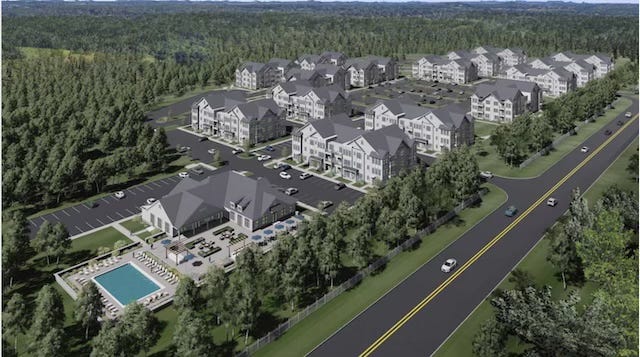Historic: Murphy DEP Approves Huge Housing Development That Will Destroy Exceptional C1 Stream Buffer And Wetlands Above A Reservoir
In A Historic First, DEP OK'd A Parking Lot Over Massive Septic System
DEP Waived Compliance With Stream Buffer, Wetlands, Water Quality, & Stormwater Regulations
Project Is By Politically Wired Kushner Companies And Langan Engineering
A massive 71,250 gallon per day novel septic system under a parking lot, along a tributary to a reservoir.
What could go wrong?
The Murphy DEP likes to issue self serving press releases stressing the "Historic" nature of their actions: historic first gay Commissioner; historic environmental justice law; historic off shore wind program et cetera.
But you won't see any press releases from DEP announcing a truly historically bad approval of a massive housing project - 360 units, with 700 parking spaces - known as Colts Neck Manor.
In order to issue that historic approval, DEP had to waive and bend beyond recognition a series of water resource, wetlands, stormwater, and C1 stream buffer regulations.
Wonks can read the DEP approval document's response to hundreds of comments opposing the project for all the gory details.
The project is located along the Category One designated Yellow Brook ("exceptional water supply significance"), a tributary to the Swimming River Reservoir that serves over 350,000 people in Monmouth County. DEP waived the 300 foot buffer protections along the Brook, putting the water supply of 350,000 people at risk. DEP issued: (@ page 5)
a hardship exception for proposed construction activities within the 300-foot riparian zone. ... the permit allows for 3.34 acres of riparian zone vegetation to be permanently disturbed
Kushner Companies has a hardship? Are you kidding me?
An opponent of the project explained the implications of that: @ p.28 - 29)
28. COMMENT: New information included in the proposed NJPDES-DGW permit reveals that the “clear” effluent from the Amphidrome Treatment Plant proposed for the Colts Neck Manor site WILL contain Fecal Coliform Bacteria above the DEP compliance threshold. The effluent could additionally contain a variety of toxic and carcinogenic chemicals to be released into disposal fields on-site and allowed to enter the groundwater and the aquifer below. When this material, including Fecal Coliform Bacteria, is intercepted by groundwater layers, which flow toward Yellow Brook, then these toxins will migrate into Yellow Brook and flow directly to the Swimming River Reservoir, along with other stormwater contaminants entering Yellow Brook and the Reservoir.
In the 1970's and '80's, DEP approved a bunch of small on site wastewater management systems. Many of those systems failed to operate properly, were poorly maintained by the developer (who abandoned them and walked away, leaving homeowners holding the bag) and polluted steams and groundwater.
DEP is repeating those errors by approving this novel and massive underground septic scheme.
There are regulated freshwater wetlands on site and adjacent to the Brook. DEP rules prohibit approval of a sewer service area that includes wetlands. But, DEP issued another historic bending of the wetlands and WQMP rules to approve the project. Check this out:
The Department determined that there are wetlands located on the proposed project site based on the “Wetlands 2012” GIS data layer, in accordance with N.J.A.C. 7:15-4.4(e)4; however, pursuant to N.J.A.C. 7:15-4.4(j)3, the applicant provided a Freshwater Wetlands Letter of Interpretation (LOI)/ Line Verification (File #1309-02-0008.1/FWW140001) confirming that there are no wetlands within the sewer service area.
The DEP issued another historic approval of a novel septic system. The 71,250 gallon per day septic system is 3 times larger than only 3 other systems built nationally and the largest I am aware of in New Jersey.
In another historic first, the novel septic system will be buried underneath a parking lot.
An opponent of the project put it succinctly:
8. COMMENT: Putting a waste management system under blacktop is insane, especially since I’m not sure if it has ever been done before or on such a large scale. The site also contains clay soil which doesn’t percolate well.
The DEP did not apply the recently updated more stringent inland flood hazard and stormwater regulations.
Again, DEP had to invent an historic interpretation to certify the permit application as "technically complete" to waive the new regulations.
An opponent summed that up:
44. COMMENT: The Stormwater Management system for this site is not in compliance with NJDEP or the town’s Stormwater Regulations. The steep slopes, wetlands, and stream corridor all lie in a buffer that is not to be disturbed. The added impervious surface must comply with current Best Management Practices. The site engineers are trying to avoid complying with Best Management practices through complicated engineering devices requiring rigorous and meticulous maintenance. Is this what we want to allow in a critical and degraded stream corridor that is one of the most important ones to serve our already degraded and threatened Swimming River Reservoir?
The DEP also completely ignored the State Plan, which maps the land as Planning Area 4 (agriculture) and Planning Area 5 (environmentally sensitive), where this kind of sprawl development is strongly discouraged.
Yes, this was truly an historic DEP approval.
And a truly historic failure to hold DEP accountable by NJ environmental groups.
A massive 71,250 gallon per day septic system under a parking lot, along a tributary to a reservoir.
What could go wrong?




